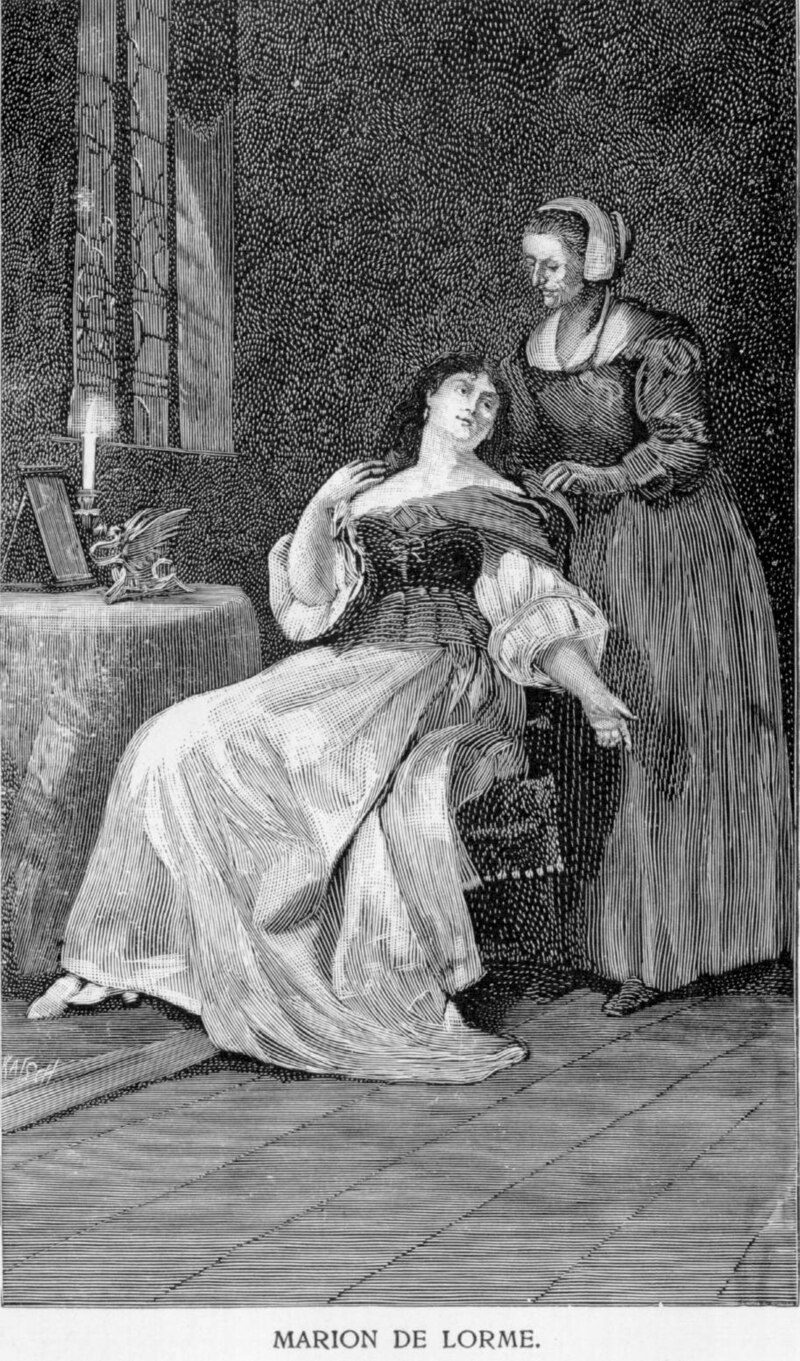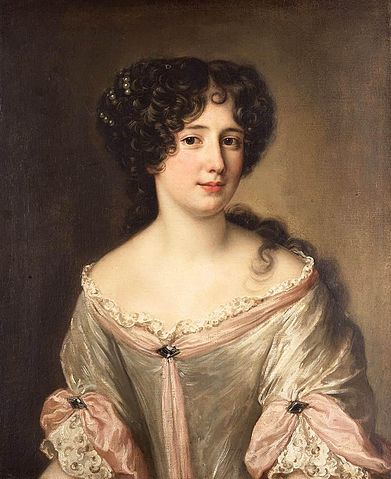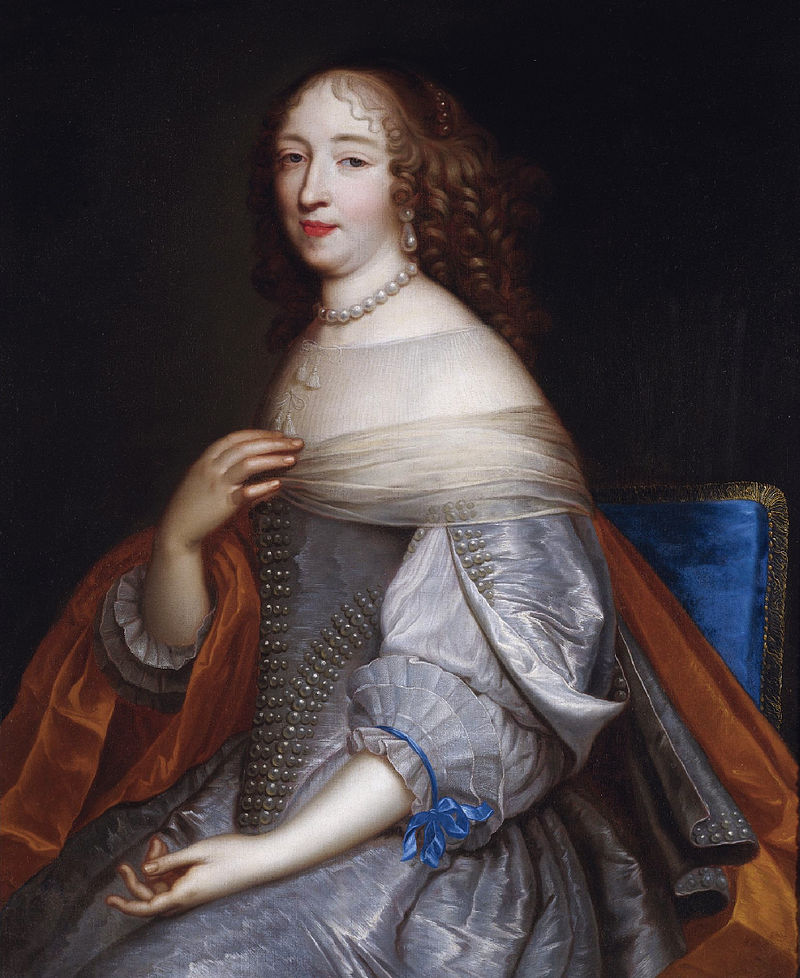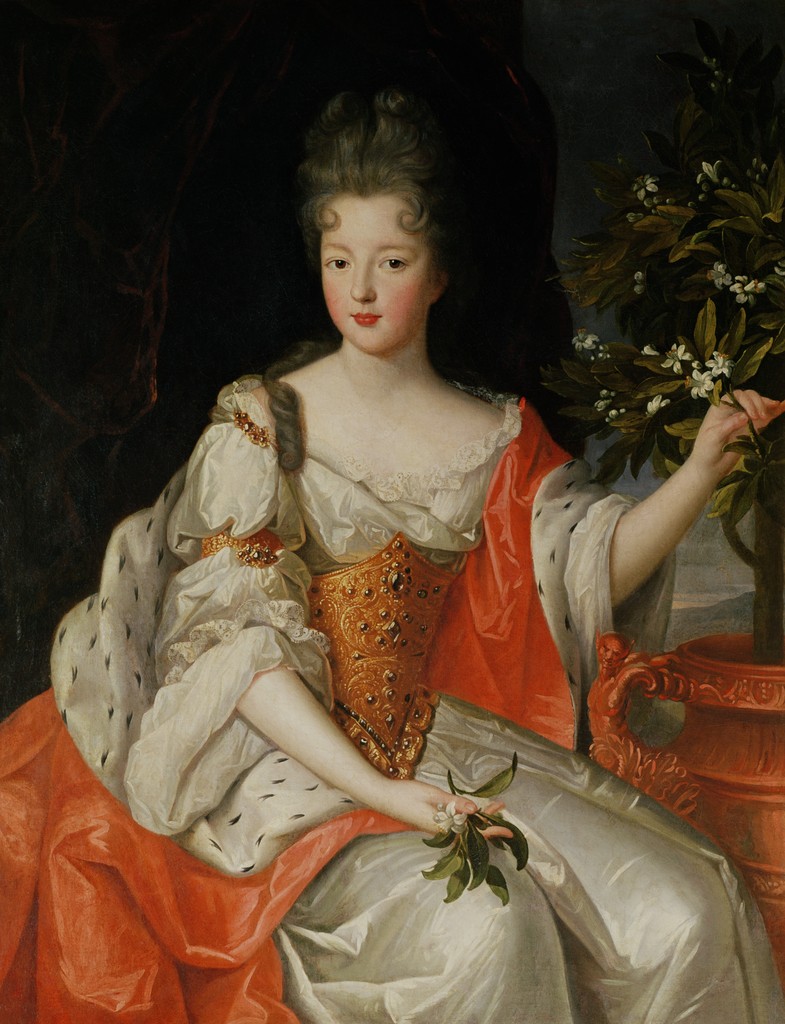Ninon de Lenclos, courtisane and femme d’esprit
Louis XIV’s court was full with witty and smart ladies. Ninon de Lenclos is one of the most famous. She was praised for her beauty, her style, her mind, her spirit, her council… the list goes on. She was legendary already during her lifetime.
 Ninon was born around 10 November 1620 as Anne de l’Enclos, also spelled de Lenclos or de Lanclos, and received the nickname Ninon from her father. Her mother was Marie-Barbe de la Marche and her father Henri de Lanclos, a quite libertine gentleman in service of Charles II de Guise-Lorraine, Duc d’Elbeuf. Henri was a musician and a bit of a free-thinker. In contrary to that, his wife Marie was very religious and more serious-minded. She wanted to raise Ninon in a strict religious spirit. Ninon’s papa saw that a bit different and wanted to work with his daughter’s natural talents… and as it turned out, his Ninon was smart and a fast learner.
Ninon was born around 10 November 1620 as Anne de l’Enclos, also spelled de Lenclos or de Lanclos, and received the nickname Ninon from her father. Her mother was Marie-Barbe de la Marche and her father Henri de Lanclos, a quite libertine gentleman in service of Charles II de Guise-Lorraine, Duc d’Elbeuf. Henri was a musician and a bit of a free-thinker. In contrary to that, his wife Marie was very religious and more serious-minded. She wanted to raise Ninon in a strict religious spirit. Ninon’s papa saw that a bit different and wanted to work with his daughter’s natural talents… and as it turned out, his Ninon was smart and a fast learner.
He taught her to play the lute and clavichord. He let her read every book she wanted, even the great philosophers, something considered not very fitting for young girls… or girls in general. She also learned various foreign languages, including Spanish and Italian. All in all, her education was more that of a boy than a girl… and if Ninon wanted, her father allowed her to dress in boy’s garments. He found it amusing, his wife found it very shocking. But she recognised her daughter’s talents and had her tour the Parisian salons for musical performances. This way, Ninon was already a star among the Parisians as a child.
The fun was over as Ninon was twelve years old and her father got exiled over a duel. It was apparently fought over a dispute involving a married woman and Henri killed his opponent. Ninon was now alone with her very pious mother. By then Ninon had already decided for herself that religion was a mere invention… and that she would remain unmarried. But her mother had other plans and the older Ninon grew, the more likely it became that her mother would marry her off to some gentleman with promising prospects. Thus Ninon made another big decision… she decided it was time to lose her virginity, because without it her mother could not possibly marry her off against her will. The Comte de Coligny was the lucky fellow to “ruin” her. Ninon’s mama was obviously not happy at all about it and rushed her to a convent as punishment.
Ninon did not stay there for long. As her mother died the following year, 1642, Ninon left the convent at once and returned to Paris. Thanks to her childhood fame, Ninon had no difficulties to be admitted to the famous Parisian salons again. The people loved her… especially the men. And Ninon loved the men. She probably did not plan on becoming a courtesan, but that is just what happened. “A woman who has loved but one man, will never know love” she said. Ninon started to take lovers as she pleased, not minding rank or something like that. She installed an own salon, not at her own lodgings, but at especially rented ones for the purpose. Since she had gained a bit of a reputation by then, her salon was mostly frequented by gentleman, but eventually she became so well-respected that the grand dames paid her visits too.
 Not just for chitchat. Ninon actually taught those ladies about love and bedsports. He lessons included how to flirt and woo, how to get a mistress or lover, or to get rid of a mistress or lover and how to deal with one’s husband/wife while having a mistress or lover. In case of gentlemen, she charged for the service, but for the ladies it was free. And if someone failed to understand this or that part, Ninon offered to take them to bed in oder to demonstrate it. Ninon had lived together with the famous courtesan Marion Delorme for a while, who taught her all the tricks.
Not just for chitchat. Ninon actually taught those ladies about love and bedsports. He lessons included how to flirt and woo, how to get a mistress or lover, or to get rid of a mistress or lover and how to deal with one’s husband/wife while having a mistress or lover. In case of gentlemen, she charged for the service, but for the ladies it was free. And if someone failed to understand this or that part, Ninon offered to take them to bed in oder to demonstrate it. Ninon had lived together with the famous courtesan Marion Delorme for a while, who taught her all the tricks.
But Ninon wouldn’t be Ninon, if she didn’t have her own tricks and set of rules. She did not like the idea of marriage, or anything remotely like it, nor did she like the idea of being financially dependant on someone. Thus she had a three months rule, meaning she would not keep a lover for longer than three months. She only broke that rule once. No matter if she had a lover or not, she would still go to paid rendezvous.
After the three months, Ninon would break with the current lover and take a new one. Surprisingly only very few of the ex-lovers were annoyed by that. Most remained friends and clients. “Ninon always had crowds of adorers but never more than one lover at a time, and when she tired of the present occupier, she said so frankly and took another. Yet such was the authority of this wanton, that no man dared fall out with his successful rival; he was only too happy to be allowed to visit as a familiar friend,” Saint-Simon wrote.
Ninon pretty much had the free pick when it came to men. Her lovers included le Grand Condé, François-Jacques d’Amboise, François-Annibal d’Estrées, Christian Huygens, Gaston de Coligny, the Duc de la Rochefoucauld and the Marquis de Villarceaux. The latter was the one she broker her three months rule with. She actually stayed with for three years, partly at his country estate, where she spent her time with studies. The Marquis chased other woman in the meanwhile. Ninon bore him a son, Louis de la Boissiere, who became a brilliant naval officer, but by then she had become rather bored by him and was longing for Paris. She broke up with him and returned there. He did not take it as well as the previous ex-lovers and chased after her in a fit of anger. As he finally found her and confronted her, cheeky Ninon took a pair of scissors and cut her hair with it, handing the thick curls to him as a sort of keepsake. He was dumbfounded and she had just invented a new fashion, the Ninon Bob.
Rumour had it that even the great Cardinal Richelieu was interested in Ninon at one point. He apparently offered her 50,000 livres, a proper fortune, for a night… but Ninon was not interested and sent her friend Marion Delorme over instead.
Ninon became the Queen of the salons and her company was highly sought. The men wanted to be with her and the women secretly wanted to be her. It appeared like everyone loved her, but that was not the case. The devout had a bit of a problem with her libertine ways and some of the higher ranking ladies at court fumed with jealousy. Ninon nicked the attention of their husbands, lovers and love-interests. And she also lured people away from the en vogue salons to her own. Ninon’s salon was not just a place to discuss love and naughty things, it was also highly frequented by the smartest minds to discuss religion, philosophy or arts. So, in 1656, Ninon had to pack her belongings and move into a convent again on orders of Anne d’Autriche.
 This stay at the couvent des Madelonnettes did not last long either. As it happened, Christina of Sweden was quite impressed by Ninon as she was visiting Paris the very year, she granted a private audience to Ninon. Queen Christina was intellectual herself who had abdicated her throne, travelled Europe and acted as patron of the arts. She was sans crown and throne, but not without influence. The young Louis XIV was very taken with her and Christine was taken with Ninon. Thus she wrote to Mazarin on Ninon’s behalf and Ninon was set free in a swift.
This stay at the couvent des Madelonnettes did not last long either. As it happened, Christina of Sweden was quite impressed by Ninon as she was visiting Paris the very year, she granted a private audience to Ninon. Queen Christina was intellectual herself who had abdicated her throne, travelled Europe and acted as patron of the arts. She was sans crown and throne, but not without influence. The young Louis XIV was very taken with her and Christine was taken with Ninon. Thus she wrote to Mazarin on Ninon’s behalf and Ninon was set free in a swift.
As a sort of response to her convent stay, Ninon created a pamphlet in 1659, called La coquette vengée, in which she argues that one can have a good life and morals without being religious. She started to work on this pamphlet while in the convent and apparently smuggled it out hidden under her garments.
Ninon returned to her salon-lifestyle and her lovers and clients. She gained friends in high places, like Jean Racine, Madame de Sevigne, Mademoiselle de Scudéry, Moliere and even Françoise d’Aubigné, the future Madame de Maintenon. She also acted as patron and took a young boy under her wings. A certain François-Marie Arouet, whom she left 2,000 livres as a scholarship in her will, and who would become famous under the pen-name Voltaire.
Also Louis XIV was very fond of Ninon and even sought her advice. Saying “What would Ninon do?” if he was not sure about this or that. Despite her courtesan adventures, Ninon became a very respectable woman and saying or doing things a la Ninon something praiseworthy. It was common for courtesans to go by Madame, but Ninon insisted to remain Mademoiselle de Lenclos. She started to reduce her clients towards the mid 1660s and did not take any new ones on after 1667, but she still kept her lovers. Ninon had become rather wealthy by then and wanted to focus more on intellectual matters. She installed a new salon, in which men and woman could freely discuss whatever they pleased…. and the whole court flocked to it. Her salon also became a safe haven for all those sceptical of the church and those who wanted to share new ideas.
Ninon had several children, but she left their upbringing to their fathers. She did not want to have anything to do with such things. As she was sixty years old, one of her sons, who had no idea who is mother was, apparently fell in love with her and as she outed herself as his mother, he shot himself.
Mademoiselle de Lenclos was eighty-four years old as she died on 17 October in 1705 in Paris. She was mourned by many. France lost one of its smartest minds, but Ninon lived on in form of her works and quotes. If God had to give a woman wrinkles, He might at least have put them on the soles of her feet.





